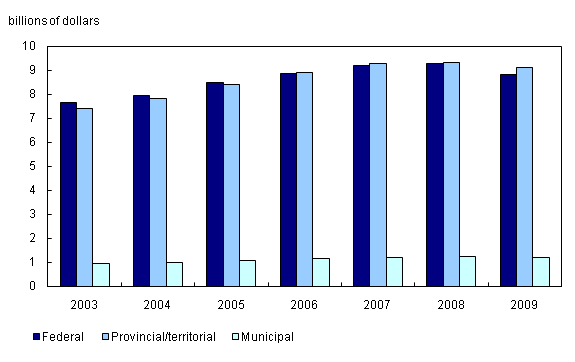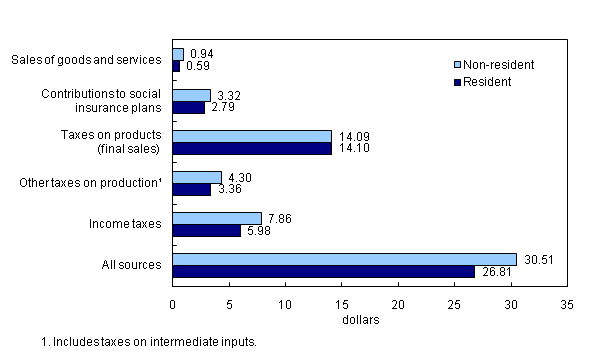Publications
Income and Expenditure Accounts Technical Series
Government Revenue Attributable to Tourism, 2009
Overview of results
Archived Content
Information identified as archived is provided for reference, research or recordkeeping purposes. It is not subject to the Government of Canada Web Standards and has not been altered or updated since it was archived. Please "contact us" to request a format other than those available.
Government revenue from tourism activities in Canada declined 3.7% to $19.2 billion in 2009. Most of the decline stemmed from a 9.6% drop in revenue directly related to tourism exports, which fell for a fifth consecutive year. Revenues from domestic tourism spending, which represent nearly four-fifths of total government revenue attributable to tourism, slipped 1.8% (see Table 3).
Since 2000, government revenue resulting from domestic tourism has increased 57%, while that attributable to tourism exports has fallen 21%. These results reflect the growth in domestic tourism over the last decade and the decline in foreign travel to Canada, most notably from the United States. The export shares of total tourism spending and government revenue due to tourism have gradually declined since 2004.
Total tourism spending declined for the first time in six years, down 4.5% in 2009. This decline stemmed from a sharp 13% drop in tourism exports. Domestic tourism spending slipped 2.1%. Interestingly, because government revenue from tourism decreased at a slower pace, every $100 spent by tourists actually generated more government revenue; $27.56 in 2009 compared to $27.33 in 2008.
This increase originated almost entirely from taxes on products, where the tax per $100 of tourism spending increased from $13.80 to $14.10. This in turn stemmed from the sharp drop in the price of vehicle fuel between 2008 and 2009, and the fact that when the price at the pump falls, the rate of excise tax rises. Because vehicle fuel accounts for nearly one-fifth of the product taxes attributable to tourism, this has a significant effect.
Tourism exports make up a larger share of the government revenue due to tourism (22%) than their share of total tourism spending (20%). This is because international visitors spend more on highly taxed items such as recreation and entertainment (including casinos) and they do not receive tax credits on business travel expenses (unlike Canadian business travellers).
Tourism generated 3.7% of the government revenue from all sources in-scope in 2009, somewhat more than tourism's 1.9% share of gross domestic product (GDP). This difference is due mainly to the relatively high taxes on many of the goods and services purchased by tourists (i.e. vehicle fuel, alcohol and casino entertainment).
Most of the revenue from tourism was collected by the federal and provincial/territorial governments (94%) while municipalities accounted for a much smaller share (see Table 4 and Chart 1). In 2009, tourism accounted for 3.8% of the federal government's revenue, 4.1% of provincial/territorial governments' revenue, and 1.9% of the revenue collected by municipalities. These shares have been quite stable over the last decade.
Table 4 Government revenue attributable to tourism, by level of government
Tourism generated $8.8 billion for the federal government in 2009, down 5.0% from the previous year. Lower revenues attributable to domestic tourism and tourism exports contributed to the decline. The export share of federal government revenue from tourism slipped for the fifth year in a row.
The federal government collected $13.25 for every $100 of tourism spending by non-residents in 2009, compared to $12.57 for every $100 spent by residents. Overall, $12.71 was collected at the federal level on every $100 of tourism spending, down from $12.78 in 2008.
Tourism brought in $9.1 billion for the provincial/territorial governments in 2009, down 2.3% from one year earlier. The decline stemmed from lower government revenue generated by tourism exports. The export share of tourism revenue for provincial/territorial governments slipped for the fifth consecutive year, to 23%. This share stood at 39% in 2000. Revenue generated through tourism domestic demand edged up.
Chart 1 Government revenue attributable to tourism, by level of government
Description for Chart 1

On average, every $100 spent by non-resident visitors generated $15.06 for provincial/territorial governments in 2009, compared to $12.61 for every $100 spent by residents. It is noteworthy that for every $100 of spending, international visitors generated considerably more revenue for provincial/territorial governments than the federal government. This stems from relatively high spending by non-residents on recreation and entertainment (including casinos) which generates significantly more revenue for provincial/territorial governments.
Municipal governments raised $1.2 billion from tourism in 2009 which is equivalent to $1.74 for every $100 of tourism spending. About 77% of this revenue was generated through other taxes on production, mainly property taxes.1
As mentioned earlier, taxes on incomes are the biggest source of revenue for government (see Table 1). In contrast, when considering only the revenue from tourism, taxes on products (final sales) are the main source. In fact, about half of all government revenue from tourism came from taxes on products, a proportion that has remained fairly stable over the last decade. These taxes brought in $9.8 billion, down 2.4% from 2008 (see Table 5).
Table 5 Government revenue attributable to tourism, by level source of revenue
About $4.4 billion was generated through income taxes, down 5.7%. Another $2.5 billion was raised through other taxes on production and intermediate inputs, while contributions to social insurance plans amounted to $2.0 billion. Government sales of goods and services to tourists added $458 million. The overall composition of government's revenue from tourism has remained relatively stable over the last decade. In contrast, the export share of each of the various sources of tourism revenue has declined markedly, reflecting the declining share of non-resident spending in overall tourism spending.
In 2009, about 44% of the decline in government revenue attributable to tourism exports came from weaker returns from taxes on products. Lower returns from all other sources also contributed. Similarly, all sources of government revenue attributable to domestic tourism decreased in 2009. In this case, however, about two-thirds of the overall decline came from lower revenue from income taxes.
Governments received $30.51 for every $100 spent by non-residents, compared to $26.81 for every $100 spent by residents (see Chart 2). The gap reflects the fact that Canadian businesses receive input tax credits for Goods and services tax (GST) and in some instances Provincial sales taxes (PST) on business travel expenses, which lowers the effective tax paid by resident tourists (which includes Canadian business travellers). It also reflects differences in spending patterns between resident and non-resident visitors, with the latter spending more on more highly taxed items, most notably recreation and entertainment (including casinos) and non-tourism commodities (including alcohol and tobacco). The following section examines some of these differences at the industry and commodity level.
Chart 2 Government revenue per $100 of tourism spending by Canadians and non-residents, by source, 2009
Description for Chart 2

Note
- Hotel room taxes are another important "source" of revenue for municipalities, however, in most jurisdictions, these taxes are collected by provincial/territorial governments and then transferred to municipalities. In this study, they are recorded as revenues of provincial/territorial governments.
- Date modified:
